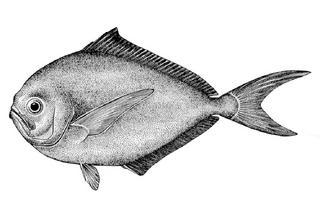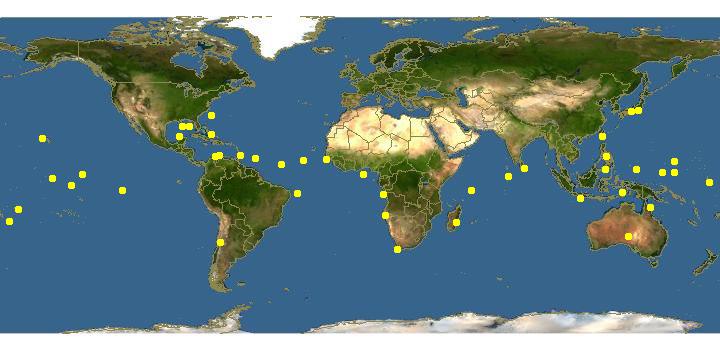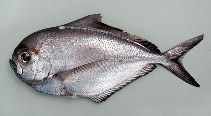
www.fao.org Copyright Michel Lamboeuf · 0
Brama dussumieri |

Click on map for details about points.
|
| Links |
We parsed the following live from the Web into this page. Such content is managed by its original site and not cached on Discover Life. Please send feedback and corrections directly to the source. See original regarding copyrights and terms of use.
- Australian Faunal Directory
- FishBase
|
|
espa˝ol |
|
|
Overview |
Main identification features
- body depth 51-58 percent sl
- 57-65 lateral scales
- gill rakers: 13-15
Head and body compressed, an elongate oval tapering to slender tail base; snout short, bluntly rounded; mouth at front, strongly oblique; between eyes strongly rounded; head profile convex; dorsal originates over pectoral, low, with almost no lobe at front; anal low, with almost no lobe at front; tail deeply concave; pectoral low on body, long, reaches to ~middle of anal fin; pelvics small, inserted under rear of pectoral base; scales small, cover body, nape, cheeks, operculum, and top jaw; 13-15 rakers on first gill arch; dorsal & anal fins scaly; body relatively deep (depth 51-58% of standard length); dorsal 33-35 (usually 34) rays; anal 26-28 (usually 27) rays; pectoral 19-22 (usually 20) rays; 57-65 lateral scales.
Dark grey, with metallic reflections; dorsal and tail dark, latter with pale margin; anal, pectoral and pelvic clear.
Size: 19 cm.
Habitat: oceanic pelagic.
Depth: 0-400 m.
Circumtropical; Nicaragua to Peru, the Galapagos, Cocos and Malpelo.
Attributes
Abundance: Common.
Cites: Not listed.
Climate Zone: Equatorial (Costa Rica to Ecuador + Galapagos, Clipperton, Cocos, Malpelo); South Temperate (Peruvian Province ).
Depth Range Max: 400 m.
Depth Range Min: 0 m.
Diet: bony fishes; Pelagic crustacea; octopus/squid/cuttlefish.
Eastern Pacific Range: Northern limit=13; Southern limit=-9; Western limit=-93; Eastern limit=-78; Latitudinal range=22; Longitudinal range=15.
Egg Type: Pelagic; Pelagic larva.
Feeding Group: Carnivore.
FishBase Habitat: Pelagic.
Global Endemism: Circumtropical ( Indian + Pacific + Atlantic Oceans); East Pacific + Atlantic (East +/or West); Transisthmian (East Pacific + Atlantic of Central America); East Pacific + all Atlantic (East+West); All Pacific (West + Central + East); TEP non-endemic; "Transpacific" (East + Central &/or West Pacific); All species.
Habitat: Water column.
Inshore Offshore: Offshore; Offshore Only.
IUCN Red List: Not evaluated / Listed.
Length Max: 19 cm.
Regional Endemism: Island (s); Continent; Continent + Island (s); Tropical Eastern Pacific (TEP) non-endemic; Eastern Pacific non-endemic; All species.
Residency: Resident.
Salinity: Marine; Marine Only.
Water Column Position: Mid Water; Near Surface; Surface; Water column only;
|
|
|
Names | |
|
|
|
Links to other sites | |
|
|
|
References |
- Cuvier , G. and Valenciennes, A., 1831., Histoire naturelle des poissons. Tome septiŔme. Livre septiŔme. Des Squamipennes. Livre huitiŔme. Des poissons Ó pharyngiens labyrinthiformes., Histoire Naturelle Des Poissons, 7:1-531.
- Fischer , W. , Krup , F. , Schneider , W. , Sommer , C. , Carpenter , K. E. and Niem, V. H., 1995., Guia FAO para la Identificacion de Especies de para los fines de la Pesca. Pacifico Centro-Oriental. Volumen II. Vertebrados - Parte 1., FAO2:647-1200.
- Jimenez-Prado, P., BÚarez, P., 2004., Peces marinos del Ecuador continental / Marine fishes of continental Ecuador., SIMBIOE/NAZCA/IFEA tomo 1 y 2.
- Mead, G. W., 1972., Bramidae., Dana Report, (81):1-166.
|
|
|
Acknowledgements | |
I thank Ashley MacDonald and John Pickering, University of Georgia, for technical support in building this page.
|
|
| Supported by | |
|
Following modified from Australian Faunal Directory
|
Top | See original
| &pull 20q v5.145 20180528: Error 301 Moved Permanently http://biodiversity.org.au/afd/taxa/9e5a9b87-40d2-49cd-87b9-2e7b1c7cad9b/ |
|
Following modified from FishBase
|
Top | See original
http://www.fishbase.org/Summary/speciesSummary.php?genusname=Brama&speciesname=dussumieri ---> http://192.134.151.83/Summary/speciesSummary.php?genusname=Brama&speciesname=dussumieri
http://192.134.151.83/Summary/speciesSummary.php?genusname=Brama&speciesname=dussumieri ---> https://fishbase.mnhn.fr/Summary/speciesSummary.php?genusname=Brama&speciesname=dussumieri
https://fishbase.mnhn.fr/Summary/speciesSummary.php?genusname=Brama&speciesname=dussumieri ---> https://fishbase.mnhn.fr/summary/Brama-dussumieri.html
Brama dussumieri, Lesser bream : fisheries

You can
sponsor
this page
Common name (e.g. trout)
Genus + Species (e.g. Gadus morhua)
-

-
About this page
-
Languages
-
User feedbacks
-
Citation
-
Uploads
-
Related species
-


 Lesser bream
Add your observation in
Fish Watcher
Upload your
photos
and
videos
Lesser bream
Add your observation in
Fish Watcher
Upload your
photos
and
videos
Pictures
|
Google image
 Brama dussumieri
Brama dussumieri
Picture by
Cambraia Duarte, P.M.N. (c)ImagDOP
Teleostei (teleosts) >
Scombriformes
(Mackerels) >
Bramidae
(Pomfrets)
Etymology:
Brama:
Old French, breme, bresme = a fresh water fish; 1460 (Ref.
45335
)
.
More on author:
Cuvier
.
Environment: milieu / climate zone / depth range / distribution range
Ecology
Marine; pelagic-neritic; oceanodromous (Ref.
51243
); depth range 1 - 300 m (Ref.
58302
). Deep-water; 31°N - 20°S (Ref.
4936
)
Circumtropical. Western Indian Ocean: East Africa to India, between the Equator and 10┬░S, Mozambique Channel, Seychelles, and Madagascar. Eastern Indian Ocean: Indonesia (Ref.
5978
) and Western Australia (Ref.
49596
). Western Atlantic: Florida and northern Gulf of Mexico in USA to Brazil (Ref.
7251
). Eastern Atlantic: 20┬░N to 20┬░S (Ref.
4936
). Eastern Pacific: Guatemala to Peru (Ref.
9282
) and Chile (Ref.
27363
).
Length at first maturity / Size / Weight / Age
Maturity: L
m
?
, range 17 - ? cm
Max length : 22.5 cm SL male/unsexed; (Ref.
45034
)
Dorsal
spines
(total): 0;
Dorsal
soft rays
(total): 32-35;
Anal
spines
: 0;
Anal
soft rays
: 25 - 28;
Vertebrae
: 39 - 43. Pectoral fins situated relatively low on body in juveniles. The distance between the base of the lowermost pectoral ray and the pelvic fin insertion less than 42% of head length (Ref.
559
).
Found near the edge of the continental shelf. Appears to spawn all year-round. Marketed fresh, and eaten fried.
An intermittent multiple spawner.
Gomes, J.
, 1990. Bramidae. p. 758-764. In J.C. Quero, J.C. Hureau, C. Karrer, A. Post and L. Saldanha (eds.) Check-list of the fishes of the eastern tropical Atlantic (CLOFETA). JNCT, Lisbon; SEI, Paris; and UNESCO, Paris. Vol. 2. (Ref.
4936
)
IUCN Red List Status (Ref.
130435
)
Least Concern (LC)
; Date assessed:
04 February 2009
CITES
Not Evaluated
Not Evaluated
Threat to humans
Harmless
Human uses
Fisheries: commercial
FAO - Publication:
search
|
FishSource
|
More information
Countries
FAO areas
Ecosystems
Occurrences
Introductions
Stocks
Ecology
Diet
Food items
Food consumption
Ration
Common names
Synonyms
Metabolism
Predators
Ecotoxicology
Reproduction
Maturity
Spawning
Spawning aggregation
Fecundity
Eggs
Egg development
Age/Size
Growth
Length-weight
Length-length
Length-frequencies
Morphometrics
Morphology
Larvae
Larval dynamics
Recruitment
Abundance
BRUVS
References
Aquaculture
Aquaculture profile
Strains
Genetics
Electrophoreses
Heritability
Diseases
Processing
Nutrients
Mass conversion
Collaborators
Pictures
Stamps, Coins Misc.
Sounds
Ciguatera
Speed
Swim. type
Gill area
Otoliths
Brains
Vision
Tools
E-book
|
Field guide
|
Identification keys
|
Length-frequency wizard
|
Life-history tool
|
Point map
|
Classification Tree
|
Catch-MSY
|
Special reports
Check for Aquarium maintenance
|
Check for Species Fact Sheets
|
Check for Aquaculture Fact Sheets
Download XML
Summary page
|
Point data
|
Common names
|
Photos
Internet sources
AFORO (otoliths)
|
Aquatic Commons
|
BHL
|
Cloffa
|
BOLDSystems
|
Websites from users
|
Check FishWatcher
|
CISTI
|
Catalog of Fishes
:
genus
,
species
|
DiscoverLife
|
ECOTOX
| FAO - Publication:
search
|
Faunafri
| Fishipedia |
Fishtrace
| GenBank:
genome
,
nucleotide
|
GloBI
|
Google Books
|
Google Scholar
|
Google
| IGFA World Record |
MitoFish
|
Otolith Atlas of Taiwan Fishes
|
PubMed
| Reef Life Survey | Socotra Atlas |
Tree of Life
| Wikipedia:
Go
,
Search
| World Records Freshwater Fishing |
Zoobank
|
Zoological Record
Estimates based on models
Preferred temperature (Ref.
123201
): 18.7 - 28.2, mean 25.9 °C (based on 1189 cells).
Phylogenetic diversity index (Ref.
82804
): PD
50
= 0.5039 [Uniqueness, from 0.5 = low to 2.0 = high].
Bayesian length-weight: a=0.01820 (0.00782 - 0.04232), b=2.96 (2.76 - 3.16), in cm total length, based on LWR estimates for this (Sub)family-body shape (Ref.
93245
).
Trophic level (Ref.
69278
): 3.8 ±0.6 se; based on size and trophs of closest relatives
Resilience (Ref.
120179
): High, minimum population doubling time less than 15 months (Preliminary K or Fecundity.).
Fishing Vulnerability (Ref.
59153
): Low vulnerability (17 of 100).
Price category (Ref.
80766
):
High
.
Back to Search
Random Species
Back to Top
Accessed through:
Not available
FishBase mirror site :
localhost
Page last modified by :
mrius-barile
- 20 July 2016
Fatal error
: Uncaught ArgumentCountError: Too few arguments to function checkEcotox(), 1 passed in /var/www/html/summary/speciessummary.php on line 2304 and exactly 3 expected in /var/www/html/includes/speciessummary.lib.php:2579 Stack trace: #0 /var/www/html/summary/speciessummary.php(2304): checkEcotox() #1 {main} thrown in
/var/www/html/includes/speciessummary.lib.php
on line
2579
|
Updated: 2024-06-16 08:22:28 gmt
|